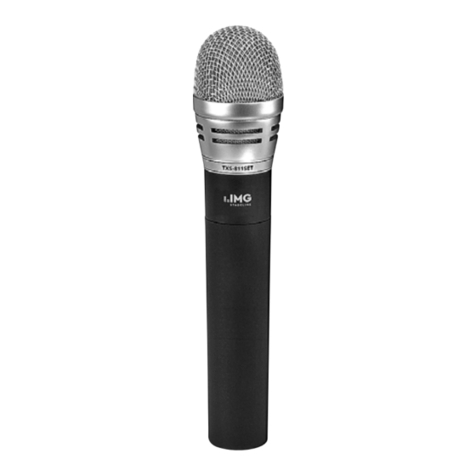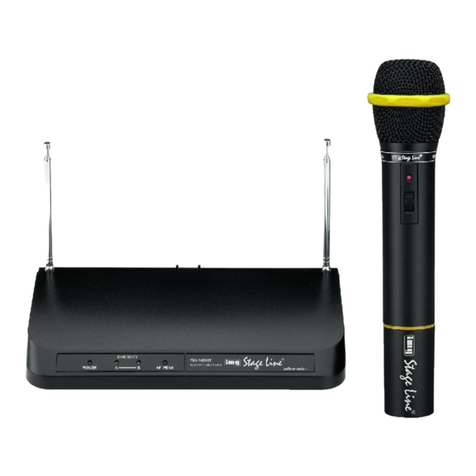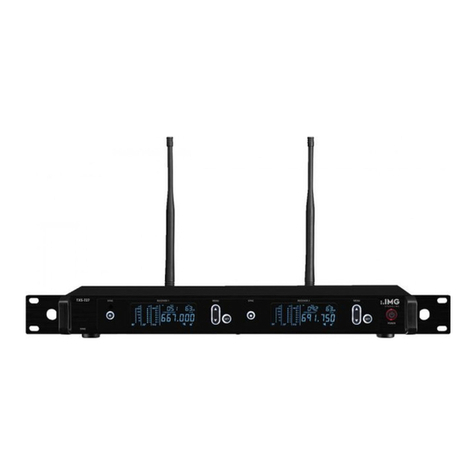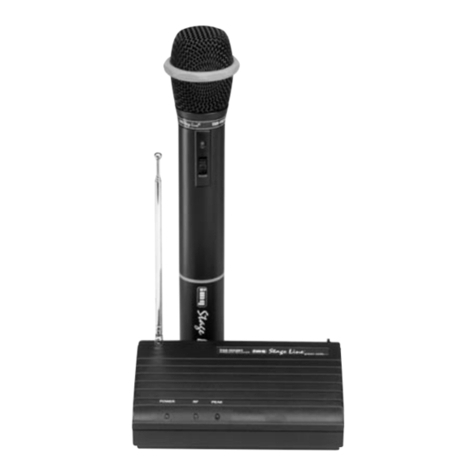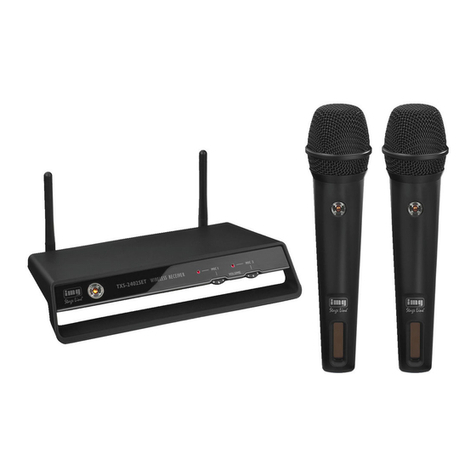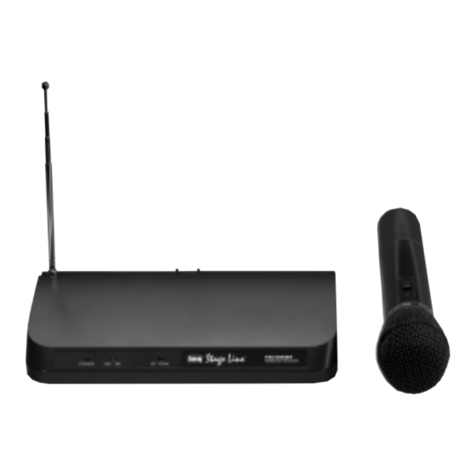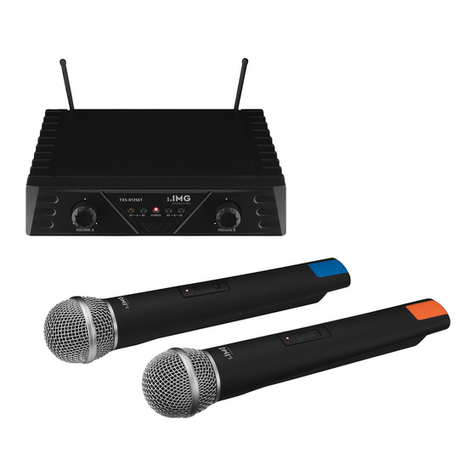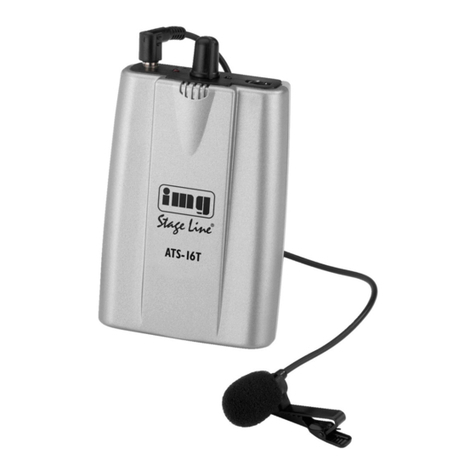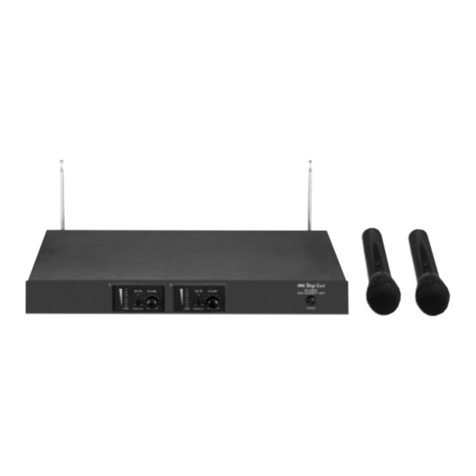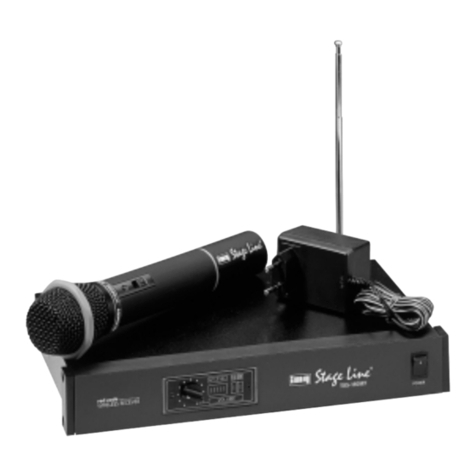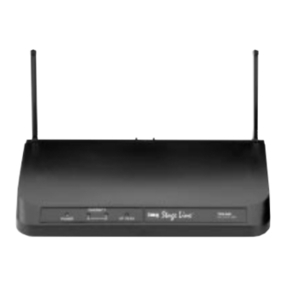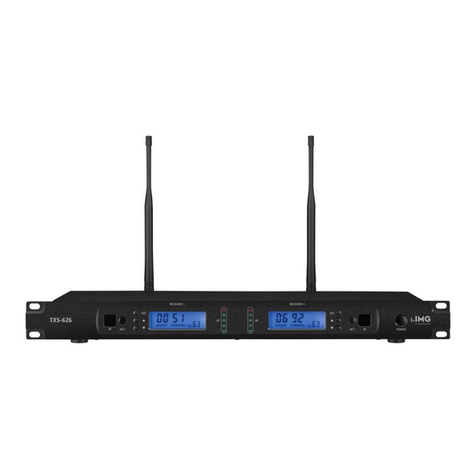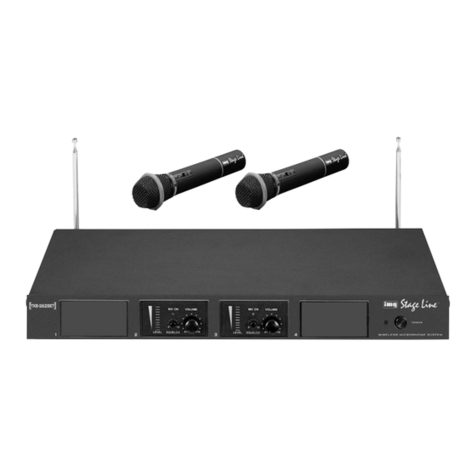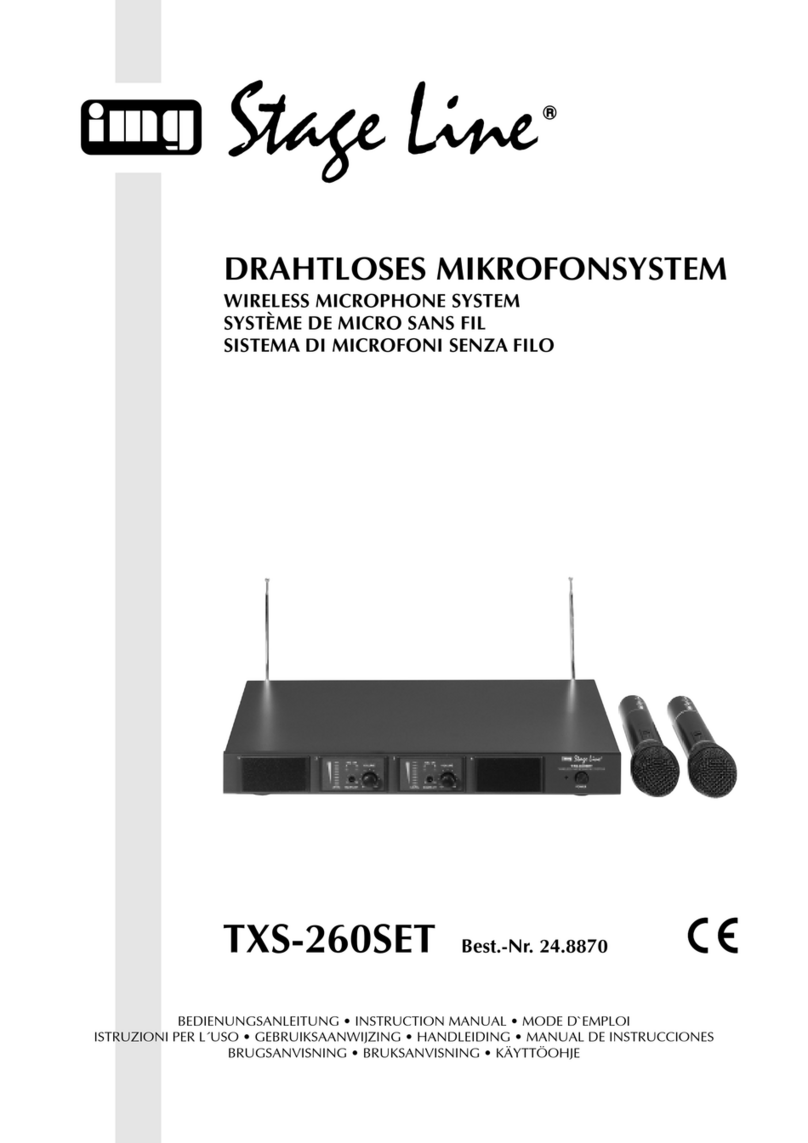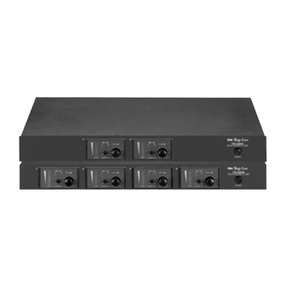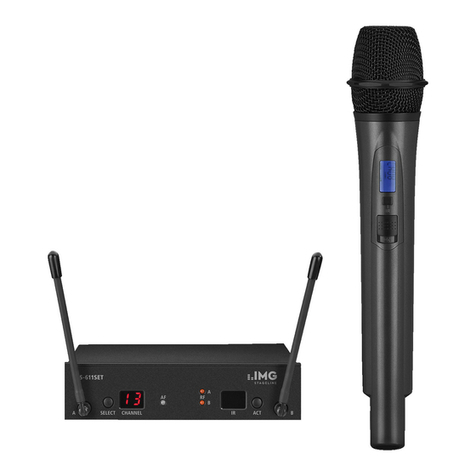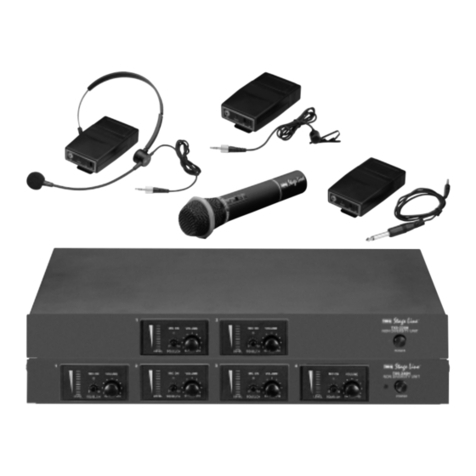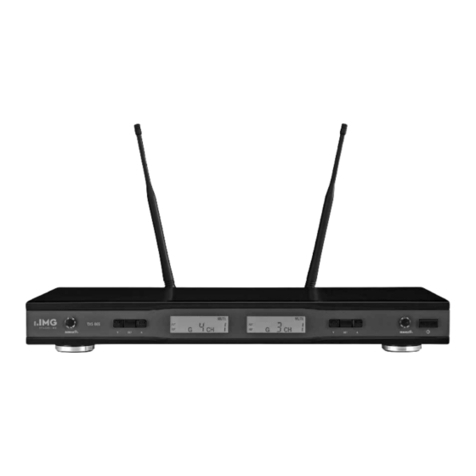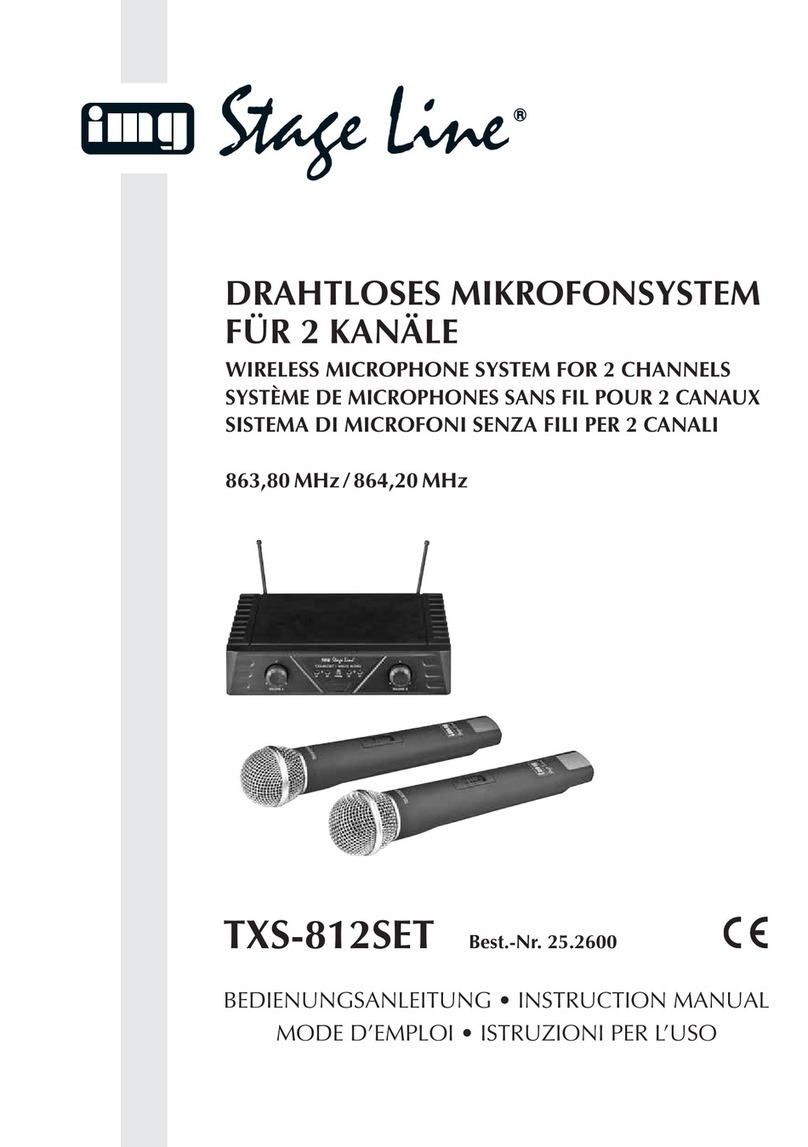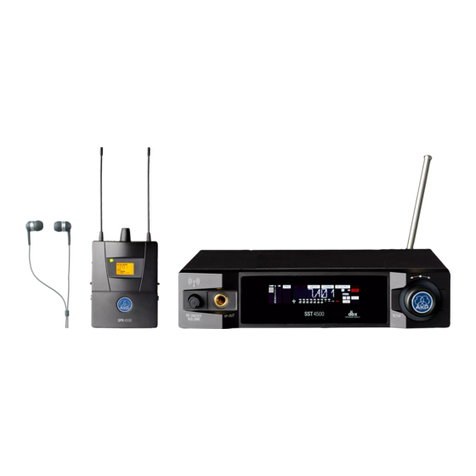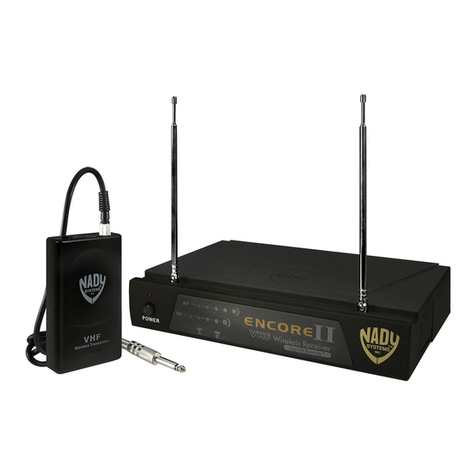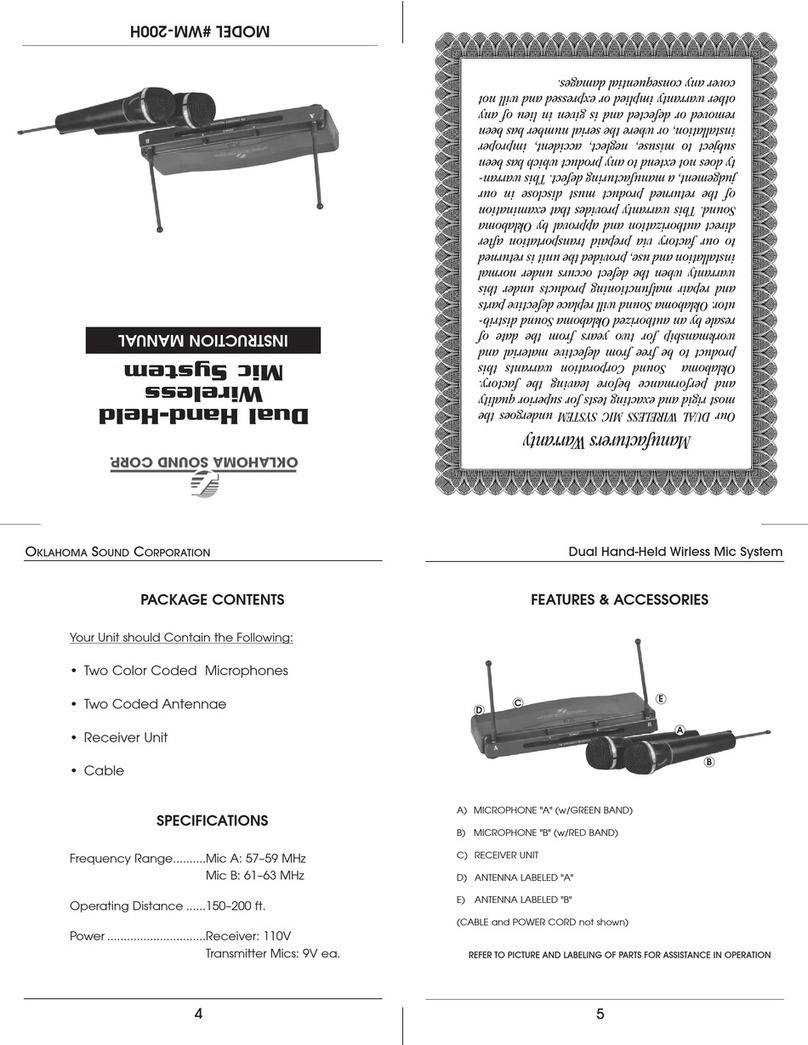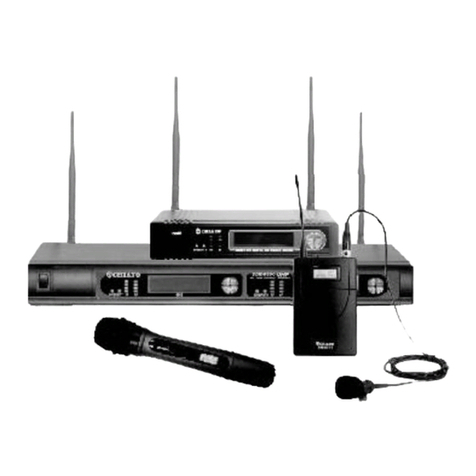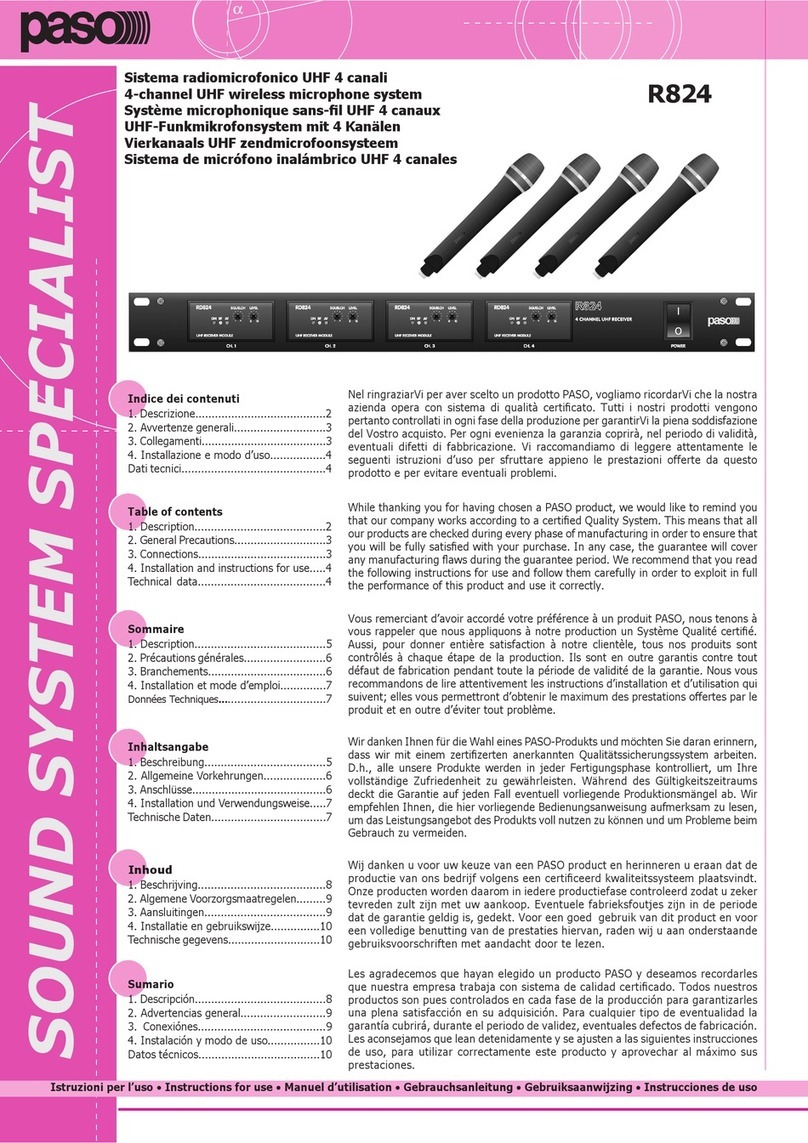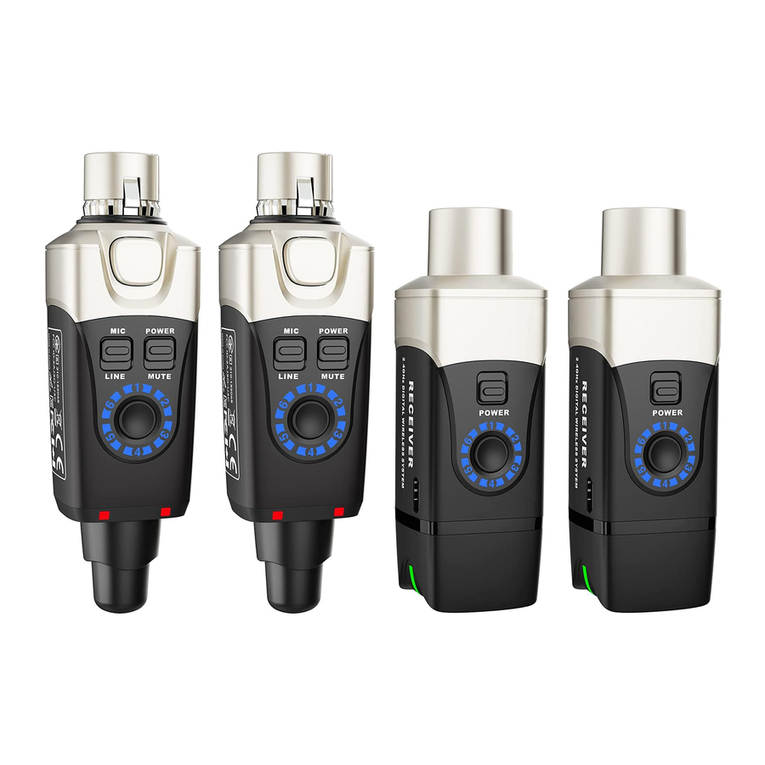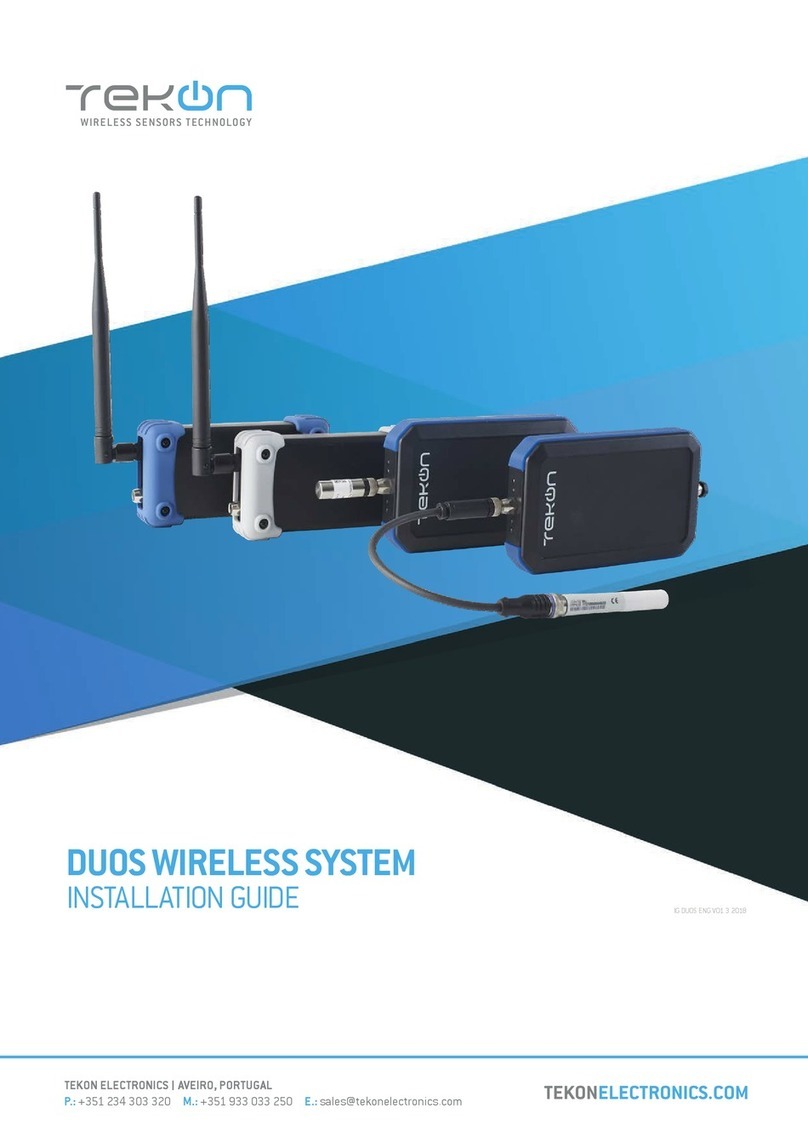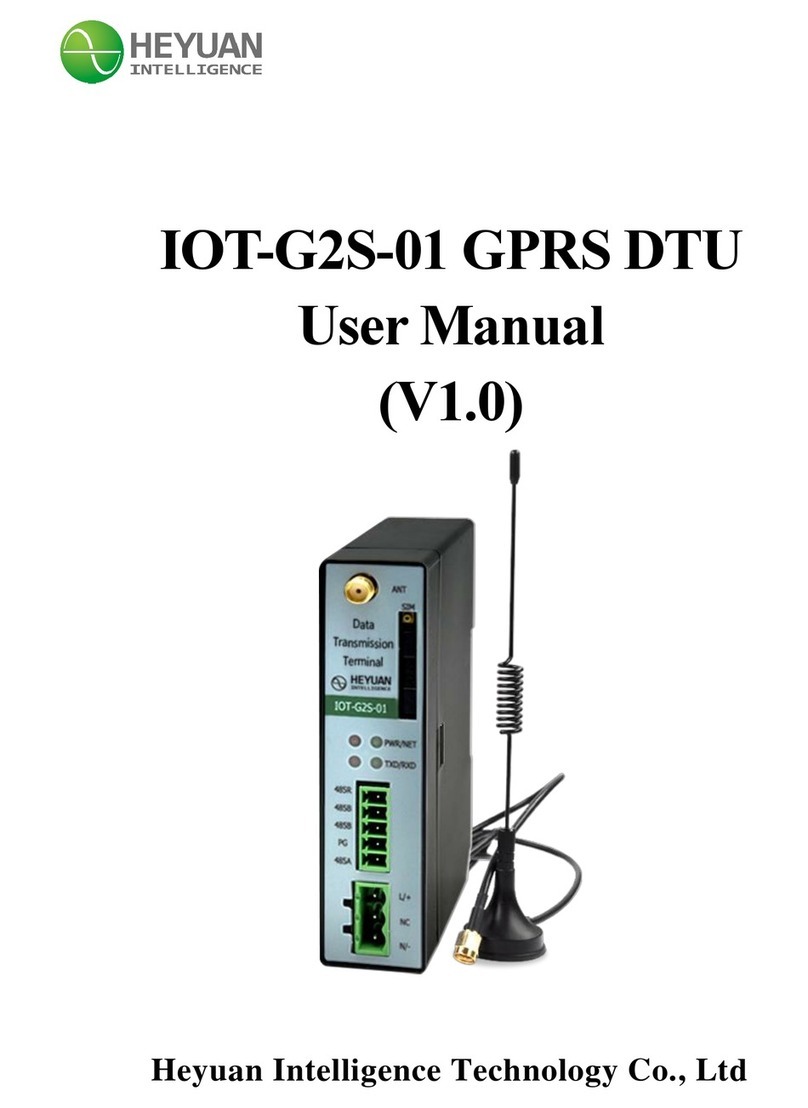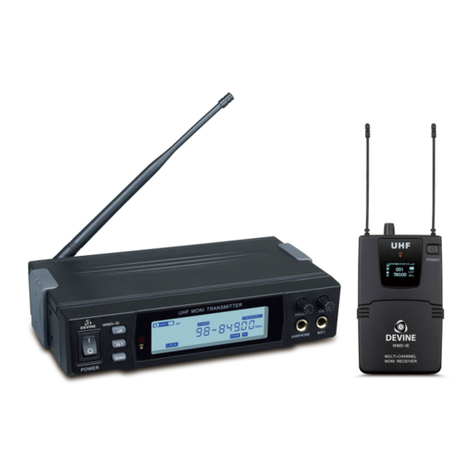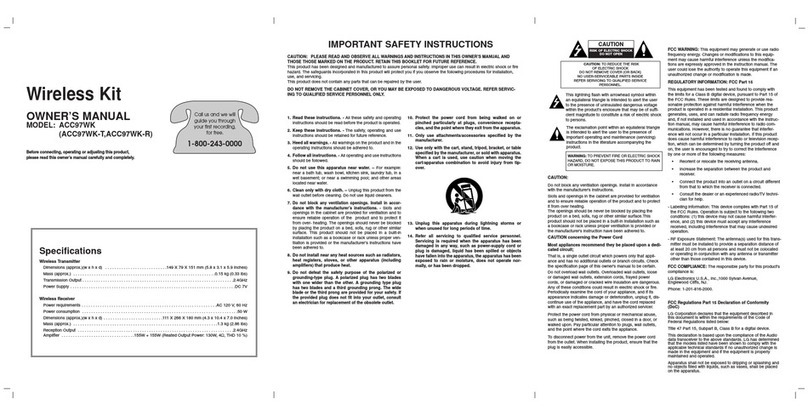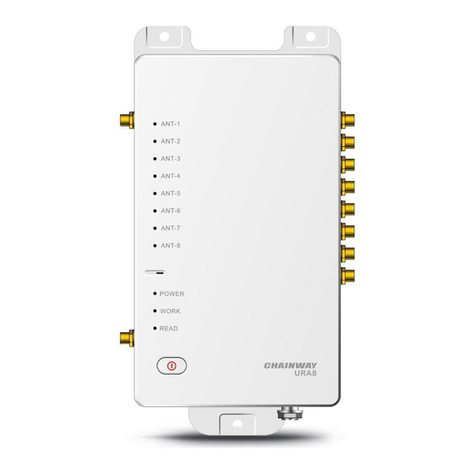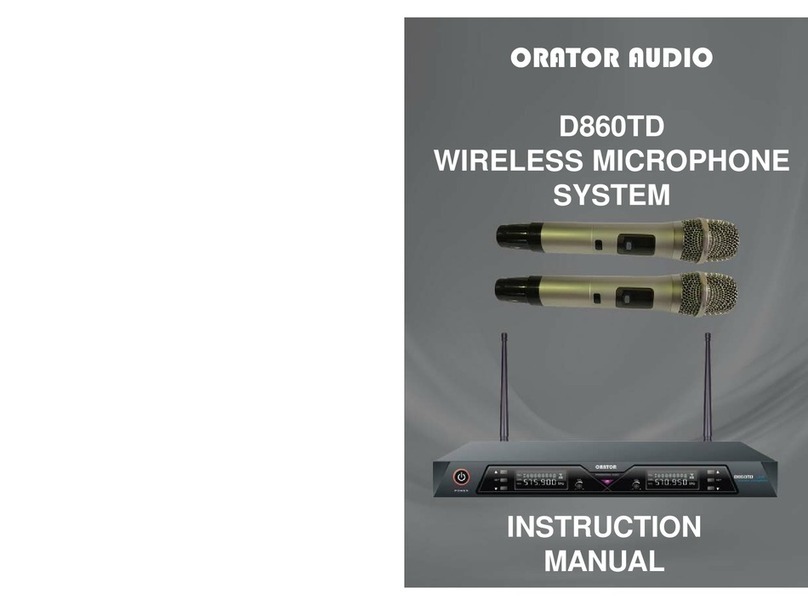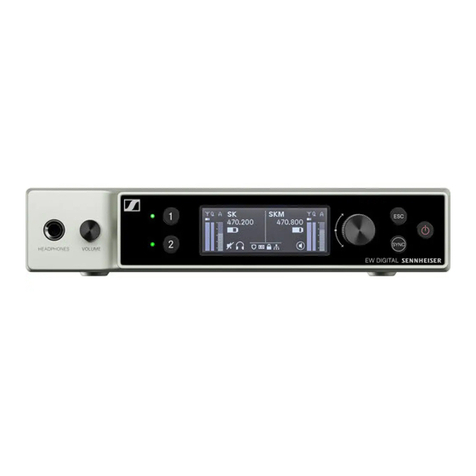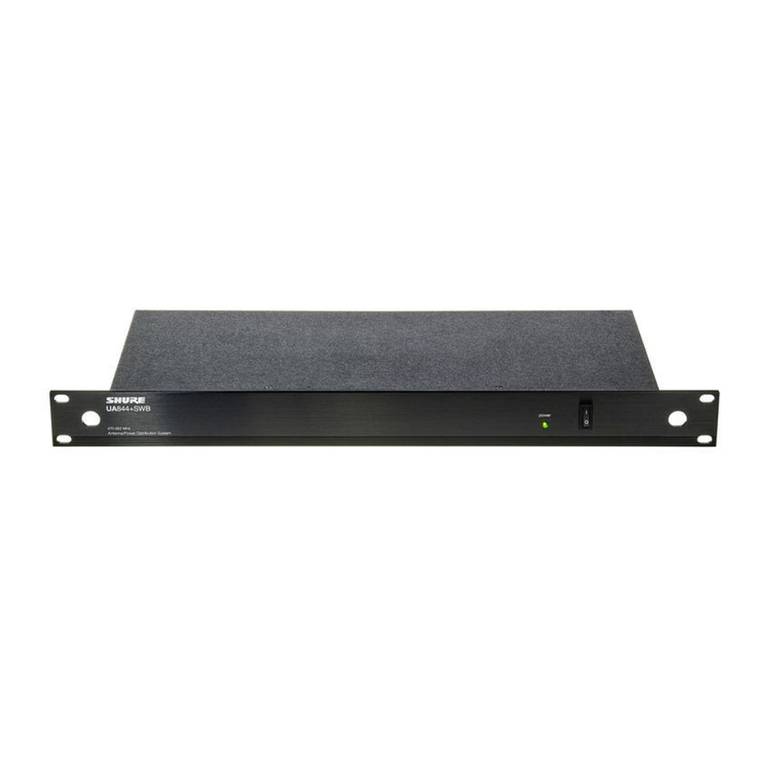Das Übertragungssystem der Serie TXS-200 von
„img Stage Line“ ist modular aufgebaut. Dadurch läßt
sich aus den folgenden Modulen je nach Anzahl der
benötigten Übertragungskanäle und der verfügbaren
Kanalfrequenzen eine drahtlose Audio-Übertragung
realisieren:
1. Empfänger (Grundgerät zum Einschub der Emp-
fangsmodule und Bedienteile)
2. Empfangsmodule für vier verschiedene Kanäle
(Frequenzen) im VHF-Bereich mit dazugehörigen
Bedienteilen
3. Sender, in der Frequenz zu den Empfangsmodu-
len passend
Die Empfänger gibt es in zwei Ausführungen:
TXS-220HD zum Einschub von zwei Empfangs-
modulen
TXS-240HD zum Einschub von vier Empfangsmo-
dulen
Die Sender gibt es in vier Ausführungen:
TXS-2..GT mit Adapterkabel zum Anschluß an ein
Instrument
TXS-2..HT als Handmikrofon
TXS-2..LT zum Anschluß des beiliegenden Kra-
wattenmikrofons
TXS-2..SX zum Anschluß des beiliegenden Kopf-
bügelmikrofons
Modulübersicht
Die Frequenz des Senders und die des Empfangs-
moduls muß übereinstimmen, d.h. jeder Sender
kann nur mit einem Empfangsmodul der gleichen
Spalte kombiniert werden.
Die Empfangsmodule arbeiten mit „True Diver-
sity“-Technik: Das Sendesignal wird von zwei räum-
lich getrennten Antennen empfangen und in zwei
Empfangsteilen getrennt weiterverarbeitet. Das je-
weils bessere Signal der beiden Empfangsteile wird
durch die Elektronik auf den Ausgang geschaltet.
4 Anmeldepflicht
Die Geräte entsprechen den gültigen Richtlinien der
Bundesrepublik Deutschland. Die Empfangsmodule
sind anmeldefrei. Für die Sender muß für jeden
Übertragungskanal eine Frequenzzuteilung bean-
tragt werden. Weitere Informationen dazu und ein
entsprechender Antrag sind jedem Sender beigelegt.
In anderen Ländern muß eine entsprechende
Genehmigung beantragt werden. Wenden Sie sich
dazu bitte an Ihren Fachhändler bzw. an Ihre
MONACOR-Niederlassung.
5 Aufstellmöglichkeiten
Der Empfänger ist als Tischgerät oder für den Ein-
schub in ein Rack (482mm/19") vorgesehen. Für
den Rack-Einbau die beiden beiliegenden Montage-
winkel links und rechts am Empfängergehäuse
anschrauben. Im Rack wird für den Einbau eine
Höhe von 1HE (1 Höheneinheit = 44,5mm) benötigt.
Sollen beim Rack-Einbau die Empfangsantennen
auf der Frontseite montiert werden, die als Zubehör
erhältlichen Montagewinkel TXS-35BNC von „img
Stage Line“ anstelle der beiliegenden Winkel ver-
wenden. Die Winkel sind mit je einer BNC-Buchse
ausgestattet, die über ein festverdrahtetes Verlänge-
rungskabel mit der Antennenbuchse des Empfän-
gers verbunden wird.
Um dieAntennen in einem größerenAbstand zum
Empfänger anzubringen, können zusätzlich die Mon-
tagewinkel TXS-100BNC von „img Stage Line“ ver-
wendet werden. Die Länge des Anschlußkabels die-
ser Winkel beträgt 1m.
6 Inbetriebnahme
6.1 Empfangsmodule einsetzen
Das Einsetzen der Empfangsmodule in das Grund-
gerät ist in der Abb. 7 dargestellt.
1) Bei Bedarf die Abdeckplatte abnehmen. Dazu die
Rastnase derAbdeckplatte mit einem Schrauben-
dreher ausrasten.
2) Die Abdeckplatte abnehmen.
3) Das Empfangsmodul wie gezeigt bis zum An-
schlag einschieben.
4) Das Anschlußkabel des Grundgerätes in das Stift-
gehäuse des Bedienteils stecken.
5) Die linke Seite des Bedienteils an die linke Kante
der Frontplattenaussparung setzen, und das kom-
plette Bedienteil durch Hineinklappen in die Aus-
sparung einrasten.
6.2 Stromversorgung
6.2.1 Empfänger
1) Das beiliegende Netzanschlußkabel zuerst in die
Netzanschlußbuchse (12) des Empfängers stek-
ken und dann in eine Steckdose (230V~/50Hz).
2) Zum netzunabhängigen Betrieb der Übertra-
gungsanlage kann der Empfänger aber auch über
eine 12-V-Batterie (z.B. Autobatterie) versorgt
werden. Der Anschluß erfolgt über die Kleinspan-
nungsbuchse DC INPUT (14). Dazu wird ein
Kleinspannungsstecker 5,5/2,1mm (Außen-/In-
nendurchmesser) benötigt. An der Steckerspitze
muß der Pluspol anliegen.
6.2.2 Handmikrofon
(Modelle TXS-2..HT, Abb. 4)
1) Die Schraubkappe (26) am unteren Ende des
Mikrofons abschrauben.
2) Eine 9-V-Batterie, mit den Plus- und Minusan-
schlüssen wie im Batteriefach (25) aufgedruckt,
einsetzen. Die Kappe (26) wieder festschrauben.
3) Mit einer frischen Batterie kann das Mikrofon ca.
6–8 Stunden betrieben werden.
2. The wire which is coloured blue must be con-
nected to the terminal which is marked with the
letter Nor coloured black.
3. The wire which is coloured brown must be con-
nected to the terminal which is marked with the
letter Lor coloured red.
Warning
-
This appliance must be earthed.
3 Applications
With this audio transmission system music and
speech can be transmitted from the transmitter to the
receiver in a wireless way. The range is approx. 30m
and depends on the local conditions.
The transmission system of series TXS-200 of
“img Stage Line” is built up in a modular way. Thus, a
wireless audio transmission can be realized by
selecting the following modules depending on the
number of the required transmission channels and
the available channel frequencies:
1. Receiver (basic unit for insertion of the receiving
modules and the operating parts)
2. Receiving modules for four different channels
(frequencies) in the VHF range with respective
operating parts
3. Transmitters matching the frequency of the
receiving modules
The receivers are available in two versions:
TXS-220HD for inserting two receiving modules
TXS-240HD for inserting four receiving modules
The transmitters are available in four versions:
TXS-2..GT with adapter cable for connection to an
instrument
TXS-2..HT as hand-held microphone
TXS-2..LT for connecting the supplied tie-clip
microphone
TXS-2..SX for connecting the supplied head-worn
microphone
Modules
The frequencies of the transmitter and the receiving
module must be the same, i.e. each transmitter can
only be combined with a receiving module of the
same column.
The receiving modules operate with “true diver-
sity” technique: the transmitting signal is received by
antennas located at a distance from each other and
is separately processed in two receiving parts. The
respectively better signal of the two receiving parts is
switched to the output by the electronics.
4 Admission for Operation
The units correspond to the valid directives of the
Federal Republic of Germany. The receiving modules
do not have to be registered. Regarding the transmit-
ters, a frequency allotment must be applied for each
transmission channel. Further information and a corre-
sponding application is supplied with each transmitter.
In other countries a corresponding approval must
be applied for. Consult your retailer resp. your
MONACOR subsidiary.
5 Installation
The receiver is provided as table top unit or for instal-
lation into a rack (482mm/19"). For rack installation,
screw on the two supplied mounting brackets at the
left and right of the receiver housing.Aheight of 1 rack
space (= 44.5mm) is required for rack installation.
If the receiving antennas are to be mounted at the
front panel when installing them into the rack, use the
mounting brackets TXS-35BNC by “img Stage Line”
(available as accessories) instead of the supplied
brackets. The brackets are equipped with one BNC
jack each which is connected via a fixed wired exten-
sion cable to the antenna jack of the receiver.
For mounting the antennas at a larger distance to
the receiver, the mounting brackets TXS-100BNC by
“img Stage Line” can additionally be used. The length
of the connection cable of these brackets is 1 m.
6 Setting into Operation
6.1 Installing the receiving modules
Fig. 7 shows the installation of the receiving modules
into the basic unit.
1) If necessary, take off the cover plate. Release the
latch of the cover plate with a screw driver.
2) Take off the cover plate.
3) Insert the receiving module up to the stop as
shown.
4) Plug in the connection cable of the basic unit into
the pin housing of the operating part.
5) Place the left side of the operating part at the left
edge of the front panel cutout, and lock in the com-
plete operating part by folding it into the cutout.
6.2 Power supply
6.2.1 Receiver
1) At first plug the supplied mains cable into the
mains jack (12) of the receiver and then into a
mains socket (230V~/50Hz).
2) For operation of the transmission system inde-
pendent of the mains, the receiver can also be
supplied via a 12 V battery (e.g. car battery). The
connection is made via the low voltage jack DC
INPUT (14). A low voltage plug 5.5/2.1mm (out-
side/inside diameter) is required. The positive
pole must be at the plug tip. 5
DEUTSCHENGLISH
Frequenz 175,00 MHz 180,00 MHz 195,25 MHz 197,10 MHz
Farbcode rot blau grün gelb
—
TXS-220MD TXS-221MD TXS-222MD TXS-223MD
—
TXS-220HT TXS-221HT TXS-222HT TXS-223HT
Hand-
mikrofon
TXS-222GT TXS-223GT
Instrumen-
tensender
—
Empfangs-
modul
—TXS-222SX TXS-223SX
Sender mit
Kopfb.-Mic
— — TXS-222LT TXS-223LT
Sender mit
Kraw.-Mic
Frequency 175.00 MHz 180.00 MHz 195.25 MHz 197.10 MHz
Colour
code red blue green yellow
—
TXS-220MD TXS-221MD TXS-222MD TXS-223MD
—
TXS-220HT TXS-221HT TXS-222HT TXS-223HT
Hand-held
microphone
TXS-222GT TXS-223GT
Instrument
transmitter
—
Receiving
module
—TXS-222SX TXS-223SX
Transm. w.
head-worn micro.
— — TXS-222LT TXS-223LT
Transm. w.
tie-clip micro.





